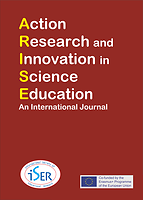Gamification in science education: a promising field for Action Research?
DOI:
https://doi.org/10.51724/arise.37Keywords:
Action research, science education, gamificationAbstract
In this editorial I outline the basic connections between playing and learning and define what a “game” actually is and how educational processes can be “gamified”. I then try to find key arguments on why games are valuable for educational purposes. Because I believe that Action Research can con-tribute to a better implementation of games in the classroom, my editorial ends with a call for papers on this issue.Downloads
References
Abt, C. C. (1970). Serious Games. New York, NY: Viking Press.
Aynsley, S. A., Nathawat, K., & Crawford, R. M. (2018). Evaluating student perceptions of using a game-based approach to aid learning: Braincept. Higher Education Pedagogies, 3(1), 478-489. https://doi.org/10.1080/23752696.2018.1435296
Csikszentmihalyi, M. (1990). Flow: The psychology of optimal experience. New York, NY: Harper Perennial.
Deterding, S., Dixon, D., Khaled, R., & Nacke, L. (2011, September). From game design elements to gamefulness: defining “gamification”. In Proceedings of the 15th international academic MindTrek confer-ence: Envisioning future media environments (pp. 9-15).
Elverdam, C., & Aarseth, E. (2007). Game classification and game design: Construction through critical analysis. Games and Culture, 2(1), 3–22.
Gros, B. (2007). Digital games in education: The design of games-based learning environments. Journal of Research on Technology in Education, 40(1), 23-38.
Hayhow, S., Parn, E. A., Edwards, D. J., Hosseini, M. R., & Aigbavboa, C. (2019). Construct-it: A board game to enhance built environment students’ understanding of the property life cycle. Industry and Higher Education, 33(3), 186-197. https://doi.org/10.1177/0950422219825985
Kafai, Y. B., & Burke, Q. (2015). Constructionist gaming: Understanding the benefits of making games for learning. Educational Psychologist, 50(4), 313-334. https://doi.org/10.1080/00461520.2015.1124022
Kim, S., Song, K., Lockee, B., & Burton, J. (2018). Gamification in learning and education. Cham: Springer.
McGonigal, J. (2011). Reality is broken: Why games make us better and how they can change the world. New York, NY: Penguin Press.
Mora, A., Riera, D., González, C., & Arnedo-Moreno, J. (2017). Gamification: a systematic review of design frameworks. Journal of Computing in Higher Education, 29(3), 516-548.
Murray, J. (2018). The play’s the thing. International Journal of Early Years Education, 26(4), 335-339.
Newmann, F. M. (1992). Student engagement and achievement in American secondary schools. New York, NY: Teachers College Press.
Pekrun, R., Cusack, A., Murayama, K., Elliot, A. J., & Thomas, K. (2014). The power of anticipated feedback: Effects on students’ achievement goals and achievement emotions. Learning and Instruc-tion, 29, 115–124. https://doi.org/10.1016/j.learninstruc.2013.09.002
Perttula, A., Kiili, K., Lindstedt, A., & Tuomi, P. (2017). Flow experience in game based learning–a systematic literature review. International Journal of Serious Games, 4(1), 57-72. https://doi.org/10.17083/ijsg.v4i1.151
Raitskaya, L., & Tikhonova, E. (2019). Gamification as a field landmark in educational research. Journal of Language and Education, 5(3), 4-10. https://doi.org/10.17323/jle.2019.10688
Roberts, J. M., Arth, M. J., & Bush, R. R. (1959). Games in culture. American Anthropologist, 61(4), 597-605.
Sailer, M., Hense, J., Mandl, H., & Klevers, M. (2017). Fostering development of work competencies and motivation via gamification. In M. Mulder (Ed.), Competence-based vocational and professional educa-tion: Bridging the worlds of work and education (pp. 795–818). Cham, Switzerland: Springer.
Tsekleves, E., Cosmas, J., & Aggoun, A. (2016). Benefits, barriers and guideline recommendations for the implementation of serious games in education for stakeholders and policymakers. British Journal of Educational Technology, 47(1), 164-183. https://doi.org/10.1111/bjet.12223
Vossen, D. P. (2004). The nature and classification of games. Avante, 10(1), 53–68.
Vygotsky, L. S. (1980). Mind in society: The development of higher psychological processes. Cambridge, MA: Har-vard University Press.
Westera, W., Nadolski, R. J., Hummel, H. G., & Wopereis, I. G. (2008). Serious games for higher educa-tion: a framework for reducing design complexity. Journal of Computer Assisted Learning, 24(5), 420-432.
Young, M. F., Slota, S., Cutter, A. B., et al. (2012). Our Princess Is in Another Castle: A Review of Trends in Serious Gaming for Education. Review of Educational Research, 82(1), 61-89. https://doi.org/10.3102/0034654312436980
Downloads
Published
Versions
- 10/01/2021 (2)
- 05/28/2021 (1)
How to Cite
Issue
Section
License

This work is licensed under a Creative Commons Attribution-NonCommercial-NoDerivatives 4.0 International License.
Copyright © Authors









